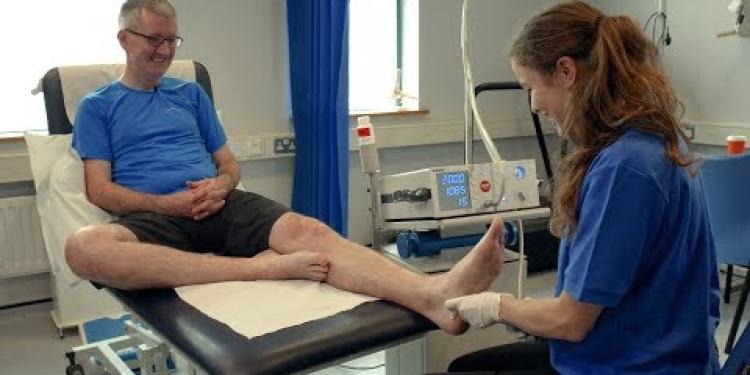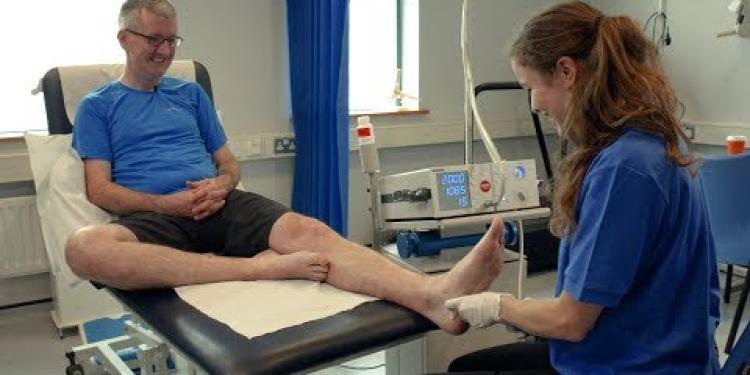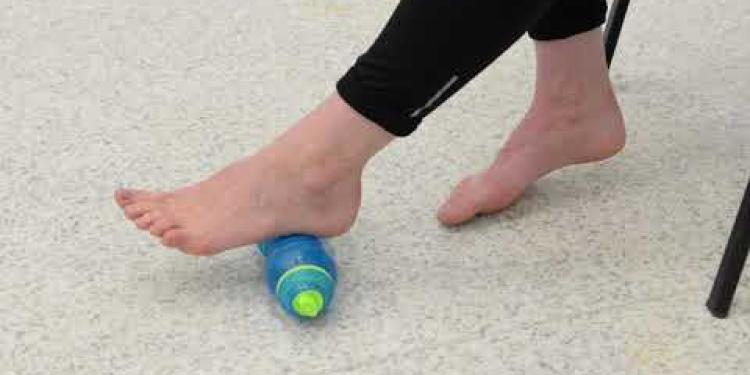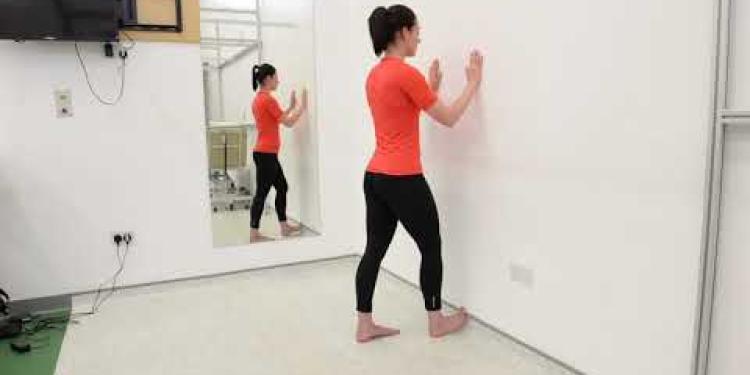Important Information On Using This Service
- Ergsy carefully checks the information in the videos we provide here.
- Videos shown by YouTube after a video has completed have NOT been reviewed by ERGSY.
- To view, click the arrow in the center of the video.
Using Subtitles and Closed Captions
- Most of the videos you find here will have subtitles and/or closed captions available.
- You may need to turn these on and choose your preferred language.
Turn Captions On or Off
- Go to the video you'd like to watch.
- If closed captions (CC) are available, settings will be visible on the bottom right of the video player.
- To turn on captions, click settings.
- To turn off captions, click settings again.
Find A Professional
Videos from Ergsy search
More Videos of Interestdiagnosis
Understanding Plantar Fasciitis
What is Plantar Fasciitis?
Plantar fasciitis is a common musculoskeletal condition that affects the heel of the foot, causing sharp pain and discomfort. It occurs when the plantar fascia, a thick band of tissue running across the bottom of the foot, becomes inflamed. This tissue connects the heel bone to the toes and supports the arch of the foot, making it essential for proper foot mechanics.
Causes and Risk Factors
The condition is often caused by repetitive strain and stress on the plantar fascia. Factors contributing to plant fasciitis include prolonged standing, high-impact exercises, improper footwear, and flat feet or high arches. In the UK, people who spend long hours on their feet, such as teachers, nurses, and retail workers, are particularly susceptible.
Symptoms
Individuals with plantar fasciitis typically experience stabbing pain at the bottom of the heel, particularly in the morning or after long periods of inactivity. The pain often subsides with movement but may return after prolonged standing or exercise. In severe cases, the discomfort can interfere with daily activities and overall quality of life.
Treatment Options
Treatment for plantar fasciitis in the UK generally focuses on relieving pain and inflammation. Initial self-care measures include rest, ice application, and over-the-counter pain relievers such as ibuprofen or paracetamol. Stretching exercises targeting the calf muscles and Achilles tendon can also help alleviate symptoms.
Professional Interventions
If these measures prove ineffective, healthcare providers might recommend physical therapy, custom orthotics, or night splints to maintain the foot in a stretched position overnight. Additionally, corticosteroid injections can offer temporary relief. In rare cases, surgical intervention might be considered to release tension in the plantar fascia.
Preventive Measures
Preventing plantar fasciitis involves maintaining a healthy weight, choosing appropriate footwear with good arch support, and incorporating foot and calf stretching exercises into daily routines. For those in the UK with occupations requiring prolonged standing, taking breaks and alternating between standing and sitting can mitigate the risk of developing plantar fasciitis.
Conclusion
Plantar fasciitis is a manageable condition with appropriate care and preventive measures. By understanding the causes, symptoms, and treatment options available in the UK, individuals can take proactive steps to alleviate pain and improve foot health. If symptoms persist, seeking medical advice is crucial for a tailored treatment plan.
Frequently Asked Questions
What is plantar fasciitis?
Plantar fasciitis is a common condition that causes pain in the heel and bottom of the foot, due to inflammation of the plantar fascia, the thick band of tissue that connects the heel bone to the toes.
What are the symptoms of plantar fasciitis?
The main symptom is pain and stiffness in the bottom of the heel, which is often worse with the first steps in the morning or after long periods of rest.
Who is at risk of developing plantar fasciitis?
Risk factors include age (40-60 years), activities that put stress on the heel, obesity, and having a high arch or flat feet.
How is plantar fasciitis diagnosed?
A healthcare provider typically diagnoses plantar fasciitis based on medical history and a physical examination. Imaging tests like X-rays or MRI may be used to rule out other conditions.
What are the treatment options for plantar fasciitis?
Treatment options include rest, ice, pain relievers, physical therapy, orthotics, splints, and in severe cases, injections or surgery.
Can plantar fasciitis be prevented?
Prevention methods include maintaining a healthy weight, wearing supportive shoes, avoiding high-impact activities, and doing stretches and exercises to strengthen the foot muscles.
How long does it take for plantar fasciitis to heal?
Recovery time varies, but with treatment, most people see an improvement within a few months. Severe cases may take up to a year.
Are there any home remedies for plantar fasciitis?
Home remedies include rest, applying ice to the affected area, stretching exercises, and wearing supportive footwear or orthotic inserts.
What types of exercises are beneficial for plantar fasciitis?
Exercises such as calf stretches, plantar fascia stretches, and strengthening exercises for the foot and ankle can be beneficial.
Is it safe to continue exercising with plantar fasciitis?
Low-impact activities like swimming or cycling are generally safe, but high-impact activities like running may worsen the condition. Always consult with a healthcare provider.
What shoes should I wear for plantar fasciitis?
Shoes with good arch support, cushioning, and a firm heel counter are recommended. Avoid flat shoes and walking barefoot.
How does obesity affect plantar fasciitis?
Obesity increases stress on the plantar fascia, which can lead to or aggravate plantar fasciitis. Weight management can help alleviate symptoms.
Can plantar fasciitis lead to other complications?
If left untreated, plantar fasciitis can lead to chronic heel pain and affect your ability to walk. It may also cause other foot, knee, hip, or back problems due to changes in the way you walk.
When should I see a doctor for plantar fasciitis?
You should see a doctor if the pain persists despite home treatments, or if it interferes significantly with your daily activities.
Can orthotics help with plantar fasciitis?
Yes, custom orthotics or over-the-counter inserts can provide additional support and relief for the heel and arch of the foot, helping to alleviate pain.
Useful Links
Useful links from: Heel pain | NHS
- Heel Pain - NHS Comprehensive guide on heel pain including symptoms, causes, diagnosis, and treatment options provided by the NHS.
- Plantar Fasciitis - NHS Detailed information on plantar fasciitis, a common cause of heel pain. Includes symptoms, treatments, and self-care tips from the NHS.
- Versus Arthritis - Heel Pain An in-depth look at heel pain, its causes, and treatment options from the UK-based charity Versus Arthritis.
- Foot Health - NHS General information on foot problems, including heel pain, their causes, and how to prevent or treat them. Provided by the NHS.
Useful links from: Plantar Fascia Wall Stretch
- NHS - Foot Pain The NHS page provides comprehensive information about various causes of foot pain, including plantar fasciitis. Here, you can learn about symptoms, treatments, including exercises such as the plantar fascia wall stretch, along with other self-care tips.
- Versus Arthritis - Foot and Ankle Pain Versus Arthritis offers detailed information about pain in the feet and ankles, including conditions like plantar fasciitis. The site includes guides on managing the condition with stretching exercises and other treatments.
- NHS Inform - Plantar Fasciitis NHS Inform provides an informative guide on plantar fasciitis, covering symptoms, causes, treatments, and specific exercises like the plantar fascia wall stretch to help alleviate pain.
- Pain Concern - Plantar Fasciitis Pain Concern offers resources and information on plantar fasciitis, focusing on managing pain through treatments that include effective stretching exercises and other therapies.
Useful links from: Plantar Fascia Loading Exercise (High Load Exercise)
- NHS - Treatment for Plantar Fasciitis The NHS page on treatment for heel pain, including plantar fasciitis, provides a comprehensive overview of various treatment options including high-load exercises.
- Versus Arthritis - Plantar Fasciitis Versus Arthritis provides detailed information on plantar fasciitis, its causes, symptoms, and various treatment options including exercise recommendations.
- NHS Inform - Plantar Fasciitis NHS Inform offers information on the symptoms, causes, and treatments for plantar fasciitis. It includes advice on exercises that can help manage pain and support recovery.
- PhysioNet - Plantar Fasciitis Exercise Program PhysioNet provides an exercise program specifically designed for plantar fasciitis, including high-load exercises to help manage and alleviate symptoms.
More Videos of Interestdiagnosis
Have you found an error, or do you have a link or some information you would like to share? Please let us know using the form below.
- Ergsy carfully checks the information in the videos we provide here.
- Videos shown by Youtube after a video has completed, have NOT been reviewed by ERGSY.
- To view, click the arrow in centre of video.
- Most of the videos you find here will have subtitles and/or closed captions available.
- You may need to turn these on, and choose your preferred language.
- Go to the video you'd like to watch.
- If closed captions (CC) are available, settings will be visible on the bottom right of the video player.
- To turn on Captions, click settings .
- To turn off Captions, click settings again.





